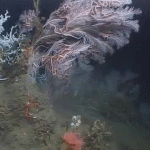 I am currently reading Descent, the story of the Bathysphere, Beebe, and Barton. Conversing with Christina Kellogg during a recent trip and the book forced my thoughts to the technological, and often psychological feats, already accomplished and those that will continue to challenge us in order to explore the deep seafloor. Because of safety, finances, logistics, and a variety of other practical reasons many institutes have justifiably turned to ROV’s (remote operated vehicles) instead of manned exploration. Perhaps this makes sense as much as turning the space programmed to unmanned missions. I myself am slanted toward ROV usage given the longer bottom times and the ability to collaborate/converse with other scientist during the dive in the control room. Collaboration in a submersible is limited to three …two scientist and a pilot. Others appear to think the same as rumors are floating that next years schedule for the ROV Jason is full compared to many openings in the Alvin schedule.
I am currently reading Descent, the story of the Bathysphere, Beebe, and Barton. Conversing with Christina Kellogg during a recent trip and the book forced my thoughts to the technological, and often psychological feats, already accomplished and those that will continue to challenge us in order to explore the deep seafloor. Because of safety, finances, logistics, and a variety of other practical reasons many institutes have justifiably turned to ROV’s (remote operated vehicles) instead of manned exploration. Perhaps this makes sense as much as turning the space programmed to unmanned missions. I myself am slanted toward ROV usage given the longer bottom times and the ability to collaborate/converse with other scientist during the dive in the control room. Collaboration in a submersible is limited to three …two scientist and a pilot. Others appear to think the same as rumors are floating that next years schedule for the ROV Jason is full compared to many openings in the Alvin schedule.
However, I wonder about the losses that come from this focus on ROV’s. Will we miss the excitement, experience, and passion that derives out of visiting these places first hand? I studied the deep sea for three years before my first deep dive and my understanding, although incomplete, of this environment has radically changed since those dives in the Sealink. I find it refreshing the Alvin, the famous submersible from Woods Hole will be replaced with a new Alvin (although it has not been officially named there is a unofficial consensus the name should stay the same). This is long over due as it was launched in 1964 and has made nearly 4,000 dives in its 41-year career. While Alvin can dive to a maximum depth of 14,764 feet, the replacement sub will be able to reach 22,500 feet and cover up to 99 percent of the ocean floor. Alvin stirs the public imagination in a way an ROV cannot, the way that space shuttles do and Mars rovers do not. Why? As long as there are manned explorations of these environments, we can all dream of visiting these unique places and experiencing them for ourselves. We can place ourselves inside the Alvin, imagine experiencing it first hand, and form a connection. How many of those who involved in the space program were motivated as children watching shuttle launches. Of course we realize that our chances of actually doing this are minute, but so are the chances of throwing a touchdown pass in the superbowl. As humans we need to dream and make the connection. I hope we continue on a balanced path of both submersible and ROV work that allows deep-sea exploration to thrive on the benefits of both.






The first day of class, my oceanography prof described the luck he had to get a chance to go on a trip in Alvin and I realized then that I’d LOVE to go. ( i’m small, i won’t take up much room!)He became quite…lost for words at one point and then giddy with remembering it and i definitely want to experience the trip myself.
I think there’s definitely a place for manned submersibles.
At the natural history museum in Basel there is currently a display on the deep sea environment. Names like “Challenger”, “Ernst Haeckel”, “Beebe” and of course “Alvin” are part of it! Saw it: liked it!
http://www.nmb.bs.ch/ausstellungen/sonderausstellung.htm